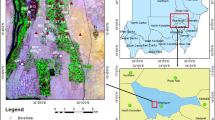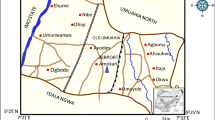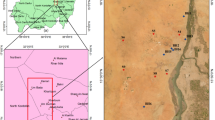Abstract
Two billion people and a half in the world do not have an adequate quantity of quality water for drinking, cooking, and bathing. This paper proposes the use of a combined hydrogeophysical approach to explore groundwater resources as solution in developing countries. The Adamawa-Cameroon region gave room to this experimental investigation this approach is proved to be realistic and efficient to reinforce groundwater resource management with limited financial resources. The approach consisted in performing 50 vertical electrical soundings (VESs) including 16 nearby existing boreholes with available pumping test outputs for device calibration, empirical regression, and comparison between measured and theoretical data. Hence, the product Kσ and the transverse resistance TR were linked by an empirical relationship using VES data from the 16 reference boreholes. For the remaining 34 VESs, this relationship is used to calculate the hydrodynamic parameters. The resistivity ranges between 3 and 82.5 Ω.m with an average of 22.8 Ω.m. The transmissivity ranges from 0.46 to 46.2 m2/day with a mean value of 15.46 m2/day. The hydraulic conductivity ranges from 0.012 to 1.677 m/day a mean value of 0.465 m/day. A feedback survey in the study area revealed that this approach has improved the water comfort of 30% of local inhabitants in 5 years. Those parameters and other ones are mapped out, and this approach can be used to characterize aquifers in various developing countries which are experiencing water stress in the world.






Similar content being viewed by others
Data availability statement
Data processed are included in the article.
References
Aretouyap, Z., Asfahani, J., Abdulrazzaq, Z. T., & Tchato, S. C. (2022). Contribution of the fuzzy algebraic model to the sustainable management of groundwater resources in the Adamawa watershed. Journal of Hydrology: Regional Studies, 43, 101198. https://doi.org/10.1016/j.ejrh.2022.101198
Aretouyap, Z., Bisso, D., & Méli’i, J.L., Njandjock Nouck, P., Njoya, A., & Asfahani, J. (2019). Hydraulic parameters evaluation of the Pan-African aquifer by applying an alternative geoelectrical approach based on vertical electrical soundings. Geofisica Internacional, 58, 113–126.
Aretouyap, Z., Bisso, D., Njandjock Nouck, P., Amougou Menkpa, L. E., & Asfahani, J. (2018). Hydrogeophysical characteristics of Pan-African aquifer specified through an alternative approach based on the interpretation of vertical electrical sounding data in the Adamawa Region, Central Africa. Natural Resources Reseach, 28, 63–77.
Aretouyap, Z., Njandjock Nouck, P., Bisso, D., Ekoro Nkoungou, H., & Meli’i, J.L., & Lepatio Tchieg, A.S. (2014a). Investigation of groundwater quality control in Adamawa-Cameroon region. Journal of Applied Sciences, 14(19), 2309–2319. https://doi.org/10.3923/jas.2014.2309.2319
Aretouyap, Z., Njandjock Nouck, P., Bisso, D., Nouayou, R., Lengué, B., & Lepatio, T. A. (2014b). Climate variability and its possible interactions with water resources in Central Africa. Journal of Applied Sciences, 14(19), 2219–2233.
Aretouyap, Z., Njandjock Nouck, P., Nouayou, R., Teikeu Assatse, W., & Asfahani, J. (2017). Aquifer porosity in the Pan-African context. Environmental Earth Sciences, 76, 1–8.
Aretouyap, Z., Nouayou, R., Njandjock Nouck, P., & Asfahani, J. (2015). Aquifers productivity in the Pan-African context. Journal of Earth System Science, 124(3), 527–539.
Asfahani, J. (2007). Neogene aquifer properties specified through the interpretation of electrical sounding data, Sallamiyeh region, central Syria. Hydrological Processes, 21, 2934–2943.
Bakr, M. (2015). Influence of groundwater management on land subsidence in deltas. Water Resources Mangement, 29(5), 1541–1555.
Carrière, S. D., Chalikakis, K., Ollivier, C., Heath, T., Mangin, M., Kempf, J., Randriatsitohaina, J. B., Gillon, M., Razakamanana, T., & Lapègue, J. (2018). Sustainable groundwater resources exploration and management in a complex geological setting as part of a humanitarian project (Mahafaly Plateau, Madagascar). Environmental Earth Sciences, 77, 734. https://doi.org/10.1007/s12665-018-7909-1
Chattopadhyay, P. B., Vedant, N., & Singh, V. S. (2015). A conceptual numerical model to simulate aquifer parameters. Water Resources Management, 29, 771–784.
Comte, J. C., Cassidy, R., Obando, J., Robins, N., Ibrahim, K., Melchioly, S., Mjemah, S., & I., Bourhane, H. A., Mohamed, I., Noe, C., Mwega, B., Makokha, M., Join, J.L., Banton, O., & Davies, J. (2016). Challenges in groundwater resource management in coastal aquifers of East Africa: Investigations and lessons learnt in the Comoros Islands, Kenya and Tanzania. Journal of Hydrology, 5, 179–199.
Duran, A. (2018). Aguas Subterráneas: Investigación aplicada en el abanico aluvial de la cuenca del río Sichez. Kipus Bolivia: Cochabamba. (in Spanish).
FAO. (2003). Review of world water resources by country. FAO.
Ghashghaie, M., Eslami, H., & Ostad-Ali-Askari, K. (2022). Applications of time series analysis to investigate components of Madiyan-rood river water quality. Applied Water Science, 12, 202. https://doi.org/10.1007/s13201-022-01693-5
He, M., & Li, P. (2022). Initial assessment on hydraulic conductivity of rock mass and its size effect using drilling data. Groundwater. https://doi.org/10.1111/gwat.13215
Heisen, K., Young, D., & Colby, J. (2022). Managed aquifer recharge for drinking water protection—glacial aquifer in cape cod Massachusetts. Groundwater. https://doi.org/10.1111/gwat.13199
Jacob, C. E. (1963). Determining the permeability of water-table aquifers. U.S. Geology Survey, 2, 245–271.
Liuzzo, L., Leonardo, V. N., & Arnone, E. (2015). Modifications in water resources availability under climate changes: A case study in a sicilian basin. Water Resources Management, 29(4), 1117–1135.
Lloyd’s. (2010). Global water scarcity: Risks and challenges for business. London: Lloyd’s. <www.lloyds.com> (Assessed on Feb. 8, 2020).
Martinez, M. B., Widdowson, M. A. C., Bott, D., Holloway, J., & Heisig-Mitchell., & Wilson, C. (2022). Demonstration of managed aquifer recharge in a coastal plain aquifer: Lessons learned. Groundwater. https://doi.org/10.1111/gwat.13197
Mende, A., Astorga, A., & Neumann, D. (2007). Strategy for groundwater management in developing countries: A case study in northern Costa Rica. Journal of Hydrology, 334, 109–124.
Nafchi, R. F., Samadi-Boroujeni, H., Vanani, H. R., Ostad-Ali-Askari, K., & Brojeni, M. K. (2021). Laboratory investigation on erosion threshold shear stress of cohesive sediment in Karkheh Dam. Environmental Earth Sciences, 80, 681. https://doi.org/10.1007/s12665-021-09984-x
Ngako, V., & Nzenti, J. P. (1991). Le Cisaillement Centre Camerounais. Rôle structural de la zone mobilepanafricaine de l’Afrique Centrale au contact du craton du Congo. Comptes Rendus De L’académie Des Sciences, 303(2), 369–381.
OCHA. (2010). Water Scarcity and Humanitarian Action: Key Emerging Trends and Challenges. Occasional Policy Briefing Series Brief No. 4, www.reliefweb.int (Assessed on Feb. 8, 2020).
Ostad-Ali-Askari, K. (2022). Developing an optimal design model of furrow irrigation based on the minimum cost and maximum irrigation efficiency. Applied Water Science. https://doi.org/10.1007/s13201-022-01646-y
Pouclet, A., Vidal, M., Doumnang, J. C., Vicat, J.-P., & Tchameni, R. (2006). Neoproterozoic evolution in the Southern Chad: Pan-African ocean basin closing. Arc accretion and late- to post- orogenic granitic intrusion. Journal of African Earth Sciences, 44, 543–560.
Trenberth, K. E., Smith, L., Qian, T., Dai, A., & Fasullo, J. (2007). Estimates of the global water budget and its annual cycle using observational and model data. Journal of Hydrometeorology, 8, 758–769.
Wada, Y., van Beek, L. P. H., van Kempen, C. M., Reckman, J. W. T. M., Vasak, S., & Bierkens, M. F. P. (2010). Global depletion of groundwater resources. Geophysical Research Letters, 37, L20402.
WHO, & UNICEF. (2019). Progress on household drinking water, sanitation and hygiene 2000–2017, Special focus on inequalities www.who.int/water_sanitation_health(Assessed on Feb. 8, 2020).
Xu, Y., Seward, P., Gaye, C., Lin, L., & Olago, D. O. (2019). Preface: Groundwater in Sub-Saharan Africa. Hydrogeology Journal, 27, 815–822.
Yadav, G. S., & Singh, S. K. (2007). Integrated resistivity surveys for delineation of fractures for ground water exploration in hard rock areas. Journal of Applied Geophysics, 62, 301–312.
Acknowledgements
The authors are very thankful to the three anonymous Reviewers who considerably improved the quality of this article.
Author information
Authors and Affiliations
Corresponding author
Ethics declarations
Conflict of interest
The authors did not receive any specific support from any funding agencies in commercial, public, or non-profit sectors for the submitted work. They have no financial, non-financial, or any other conflict of interest to disclose.
Rights and permissions
Springer Nature or its licensor (e.g. a society or other partner) holds exclusive rights to this article under a publishing agreement with the author(s) or other rightsholder(s); author self-archiving of the accepted manuscript version of this article is solely governed by the terms of such publishing agreement and applicable law.
About this article
Cite this article
Aretouyap, Z., Teikeu, W.A., Tchato, S.C. et al. Contribution of a hydrogeophysical approach to groundwater resource management in the developing world. Int J Energ Water Res 7, 375–386 (2023). https://doi.org/10.1007/s42108-022-00225-w
Received:
Accepted:
Published:
Issue Date:
DOI: https://doi.org/10.1007/s42108-022-00225-w




